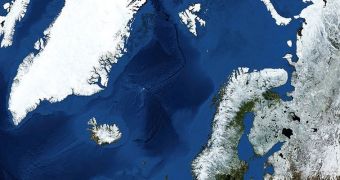Investigators with the United States Geological Survey (USGS) say that they recently identified a series of factors that may hinder climate models. One of them is the presence of the Greenland-Scotland Ridge in the North Atlantic Ocean. This structure may be influencing climate patterns in the area.
Scientists are looking for ways to improve their work at all times. The same goes for the climate models they set up, which always run on the latest available data. Findings such as this one will soon go into all climate simulations, allowing them to become even more accurate than ever before.
USGS scientists apparently believe that the underwater structure may be influencing the circulation system established in the waters above to a much greater extent than thought possible.
In all fairness, researchers never even thought that the presence of underwater ridges could play such a role in determining the behavior of the water above. The main mechanism through which these structures act revolve around trapping cold, dense water at the bottom of the sea.
Generally, the flow of warm surface water increases only when deepwater flows freely. When this happens, oceanic circulation patterns are also sped up, the USGS team says. This is not what researchers found around the Greenland-Scotland Ridge.
Whenever the surface of the ocean experiences more warm water circulation, it naturally becomes hotter, preventing ice from covering it during the winter. The bad news is that these areas continue to emit heat around the year, affecting regions that would normally get covered by ice sheets.
The more areas of the ocean become ice-free, the warmer the waters get, and the more ice melts. This vicious circle is one of the main threats to Arctic ices. Until now, experts had no idea underwater ridges played a role in this phenomenon.
In order to gain a better understanding of the interactions at work here, experts at the USGS looked at the influence the Ridge had on ancient Earth's climate, during the mid-Pliocene warm period, some 3 million years ago.
“Sea-surface temperatures in the North Atlantic and Arctic Oceans were much warmer during the mid-Pliocene warm period than they are today, but climate models so far have been unable to fully understand and account for the cause of this large scale of warming,” USGS scientist Marci Robinson explains.
“Our research suggests that a lower height of the Greenland-Scotland Ridge during this geologic age was a contributor to the increase of poleward heat transport,” she goes on to say.
“This is the first time the impact of a North Atlantic underwater ridge on the ocean circulation system was tested in a mid-Pliocene experiment. Understanding this process allows for more accurate predictions of factors such as ocean temperature and ice volume changes,” the expert concludes.
Details of the new USGS study appear in the latest online issue of the esteemed journal Palaeogeography, Palaeoclimatology, Palaeoecology.

 14 DAY TRIAL //
14 DAY TRIAL //